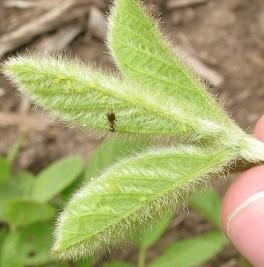We are beginning to see soybean aphids colonizing some soybean fields in southern Minnesota. These aphids are in very low numbers and only on a small fraction of the plants, so they are currently not a threat to yields. However, late June is a good time to begin scouting for soybean aphids. Initially, prioritize scouting “indicator” fields, which are the fields where you typically see soybean aphids colonizing first. Often, these are early planted fields, small fields with wooded borders, and fields in areas with abundant buckthorn. Finding aphids on plants early in the colonization process when aphids are few and far between can be challenging, but the presence of lady beetles and ants on soybean plants often a sign that aphids are there. Indicator fields can provide the first clues on the number of aphids that were able to move from buckthorn to soybean and if (or how fast) populations are increasing.

We do not know how the soybean aphid populations will play out this year. The low soybean aphid populations last year combined with the cold winter temperatures, left us assuming we might have low soybean aphid populations this year. Variability in the timing of soybean planting across the landscape and spring weather conditions will likely lead to variable levels of aphid infestation in fields across a region and even across an individual farm. Soybean planted with a neonicotinoid seed treatment may be protected by that seed treatment up to about the V3 growth stage (3 expanded trifoliate leaves). As the season progresses, decisions for applying foliar insecticides against soybean aphid in individual fields should be based on scouting and the use of thresholds. Fields should be scouted on a regular basis. The decision to apply a foliar insecticide for soybean aphid should be based on the economic threshold of 250 aphids per plant, with most of the plants infested, and aphid populations increasing. Remember, the economic threshold is the trigger point to start lining up an insecticide application to prevent the infestation from increasing to damaging levels.
Insecticide options available for soybean aphid management are more limited than in previous years. Please remember that chlorpyrifos has been revoked and can no longer be used on soybean. In addition, we continue to find populations of soybean aphid with resistance to pyrethroid insecticides, like lambda-cyhalothirn and bifenthrin. Some of the newer insecticides, such as afidopyropen (Sefina), sulfoxaflor (Transform), and flupyradifurone (Sivanto) have been shown to be effective against soybean aphid in our research and are less toxic to beneficial insects such as predators like lady beetle.
Source : umn.edu